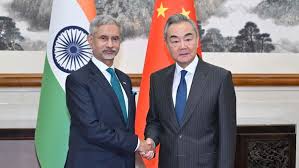India-China ties have made good progress, border de-escalation is key, says Jaishankar

New Delhi, July 15 – External Affairs Minister Dr. S. Jaishankar on Monday emphasized that while India-China relations have seen forward movement in recent months, the long-standing border tensions remain a critical obstacle to restoring full normalcy. Speaking at an event in New Delhi, Jaishankar asserted that sustained progress in bilateral ties hinges upon de-escalation along the Line of Actual Control (LAC).
Constructive Engagement Amid Challenges
India and China, two of Asia’s most influential powers, have endured a tense diplomatic phase since the 2020 Galwan Valley clash in eastern Ladakh, where 20 Indian soldiers and an unspecified number of Chinese troops were killed. Since then, both nations have engaged in a series of high-level military and diplomatic dialogues to reduce tensions.
“There has been some progress in India-China relations,” said Jaishankar. “But let us be clear: the situation at the border must return to peace and tranquility. That is a precondition for any substantial forward movement in other areas.”
The minister’s remarks come ahead of anticipated meetings between Indian and Chinese officials, potentially on the sidelines of international summits. These meetings are expected to focus on further disengagement at remaining friction points in Ladakh and resuming broader cooperation on trade, climate, and regional security.
Why Border De-escalation Remains the Key Issue
Despite over 20 rounds of military commander-level talks, several flashpoints along the LAC—particularly in Depsang and Demchok—remain unresolved. Indian officials maintain that a full restoration of pre-April 2020 status quo is essential for restoring mutual trust.
“We cannot compartmentalize the relationship,” Jaishankar reiterated, rejecting suggestions that trade and economic cooperation could proceed independently of security concerns.
This position has been a consistent Indian stance since 2020. China, on the other hand, has urged a “forward-looking” approach that does not hold the border standoff as a barrier to cooperation in other areas.
However, Jaishankar dismissed the notion of “business as usual,” pointing out that bilateral ties must be based on mutual respect, sensitivity, and adherence to agreements.
Trade Ties Continue Despite Strained Diplomacy
Interestingly, while diplomatic ties have remained under strain, bilateral trade between India and China touched a record $136 billion in 2023. China continues to be India’s largest trading partner, though India’s trade deficit with Beijing has widened—raising economic concerns among policymakers in New Delhi.
To counterbalance this, India has been strengthening trade ties with other Asian economies, boosting self-reliance under the “Atmanirbhar Bharat” initiative, and scrutinizing Chinese investments more closely—particularly in tech, telecom, and infrastructure sectors.
Regional Implications and Global Concerns
The India-China rivalry extends beyond bilateral concerns. Both countries are key players in the Indo-Pacific region, and their border conflict has regional security implications. India’s closer ties with the Quad (US, Japan, Australia, India) and its participation in strategic dialogues have irked Beijing, which views such alliances as containment strategies.
At the same time, China’s growing military assertiveness in the South China Sea, Taiwan Strait, and Himalayan region has drawn international concern. Western powers, including the United States, have repeatedly backed India’s position on border de-escalation and emphasized the importance of respecting territorial sovereignty.
Diplomatic Path Forward
Despite the complex dynamics, both nations appear to be engaging in a cautious diplomatic recalibration. Indian officials have signaled willingness to continue talks, and recent months have seen increased cultural exchanges and limited ministerial-level communication.
Jaishankar concluded by saying, “We are open to engagement. But that engagement must be based on clear principles and mutual respect. Peace on the border is not just desirable, it is essential.”
As India gears up for key diplomatic engagements in 2025, including the BRICS Summit and G20-related forums, observers believe the handling of the China relationship will remain a top priority for New Delhi.
Conclusion
While India-China relations have moved away from their lowest point post-Galwan, the road to normalization remains steep. The core issue—border stability—continues to cast a long shadow over bilateral cooperation. As External Affairs Minister S. Jaishankar rightly pointed out, meaningful progress in ties can only be achieved when peace and trust are fully restored along the LAC.






